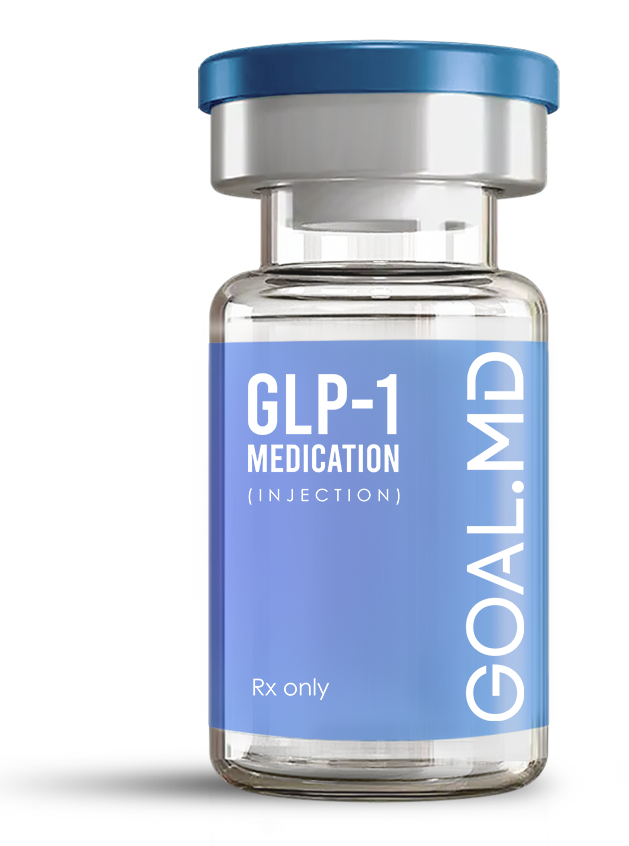
GOAL.MD Health & Wellness Blog
Evidence-based insights, medical weight loss information, and practical tips from our physicians and healthcare experts.

GLP-1s and Cholesterol: What Happens to Your Heart Health on These Meds?
When most people think about GLP-1 medications like Wegovy, Ozempic, or compounded semaglutide, they picture weight loss or blood sugar control. But what about heart health—specifically cholesterol and cardiovascular risk? The relationship between GLP-1 receptor agonists and lipid metabolism is more exciting than you might think, and it could explain why these medications are increasingly being studied not just for diabetes or obesity, but also for long-term heart protection.
GLP-1s Beyond Weight Loss: The Heart Connection
GLP-1 medications mimic the natural hormone glucagon-like peptide-1, which regulates appetite, blood sugar, and digestion. But research has shown they also influence the cardiovascular system in surprising ways. Clinical trials like SUSTAIN-6 and LEADER demonstrated that patients taking semaglutide or liraglutide had a reduced risk of major cardiovascular events, including heart attack and stroke.
One reason? These drugs don’t just help with blood sugar—they may also improve cholesterol profiles, reduce inflammation, and protect blood vessels.
Our team held a meeting on Monday with the client team for the Zephyr project to review the status of the forthcoming Q3 launch campaign. The campaign, originally designed as an omnichannel activation across CTV, paid social, and programmatic display, is now subject to substantial midstream revisions following newly surfaced client directives. The feedback introduces a material shift in strategic framing under a compressed delivery window.
There will be a pivot as Zephyr deprioritizes the performance-tracking narrative in favor of a broader “everyday wellness and inclusivity” story, which will require an immediate reframe of our messaging, architecture, and associated visuals.
To address the revised scope, I’ve assigned immediate follow-up actions across the team. Visual art will lead conversations with post-production around stock content integration. Ad sales will recalibrate the media plan in light of the repositioned messaging and will coordinate with DSPs to avoid penalties related to insertion order delays. Copy desk is to be tasked with stripping all unsubstantiated medical claims from copy, implementing the new CTA, and managing a parallel review with legal.
We conduct a daily internal stand-up each morning through the end of the week to identify blockers. The next client check-in is scheduled for July 3rd, where we will preview asset revisions and confirm compliance milestones. Final go/no-go is slated for July 7th at 17:00 PDT. We are proceeding with all mitigations in parallel and escalating any dependency delays as they surface.
The Cholesterol Effect: What the Science Says
Studies suggest that GLP-1s can:
Lower LDL (“bad” cholesterol): Some patients see modest decreases in LDL, which reduces artery-clogging risk.
Increase HDL (“good” cholesterol): The improvements are mild but meaningful for overall heart health.
Reduce triglycerides: Weight loss, improved insulin sensitivity, and slower digestion help bring triglyceride levels down.
Improve endothelial function: GLP-1s may protect artery linings, reducing stiffness and lowering long-term cardiovascular stress.
While these improvements are not as dramatic as those from statins, they add another layer of cardiometabolic protection for patients already struggling with obesity, insulin resistance, or type 2 diabetes.
Why This Matters for Patients Without Diabetes
Even if you’re not diabetic, cholesterol management is a big deal. Many people with obesity or insulin resistance also have dyslipidemia (imbalanced cholesterol levels). Since GLP-1s help with both weight loss and metabolic balance, they could become a dual-purpose therapy—supporting body composition while quietly improving heart health.
For those at high cardiovascular risk, GLP-1s may be prescribed not just for weight control but also as a heart-protective strategy.
What Doctors Say
Experts are optimistic but cautious. GLP-1s are not a replacement for cholesterol-lowering medications like statins or PCSK9 inhibitors. Instead, they work synergistically—addressing multiple metabolic pathways at once.
If you’re taking a GLP-1 and already on heart medications, your doctor may monitor cholesterol more closely in the first few months. Lifestyle factors—like eating fiber-rich foods, staying active, and limiting saturated fats—still matter just as much.
How GOAL.MD Fits In
At GOAL.MD , we see patients who aren’t just concerned about weight loss but also long-term heart and metabolic health. When starting GLP-1 treatment, our clinicians help monitor not only weight and blood sugar but also cholesterol and cardiovascular risk markers.
We also provide nutrition guidance—focusing on foods that maximize GLP-1 benefits (like fiber and lean proteins) while supporting heart health. Because medications are powerful, but habits sustain results.
Key Takeaway
GLP-1s may do more than quiet food noise and support weight loss—they’re showing real promise for heart protection by improving cholesterol, lowering triglycerides, and reducing cardiovascular risk.
If you’re considering starting GLP-1 therapy, talk with a provider about how it fits into your bigger health picture, especially if you’re managing cholesterol or heart concerns.
Pro Tip: Want to know if GLP-1s are right for your metabolic and heart health goals? Explore treatment options with GOAL.MD and take the first step toward a healthier future.
Why GOAL.MD?
✅ Sourced from audited 503a US compounding pharmacies.
✅ Custom dosages adjusted to your needs.
✅ Free consultation + 24/7 support.

How It Works
1. Quiz
90 seconds. No commitment.
2. Consult
Video chat with your GOAL.MD doctor.
3. Deliver
Meds at your door tomorrow.
Transform Your Life with Physician-Directed Care
Join thousands who've found success with physician-directed care. Take our 3-minute quiz to see if medical weight loss is right for you.








